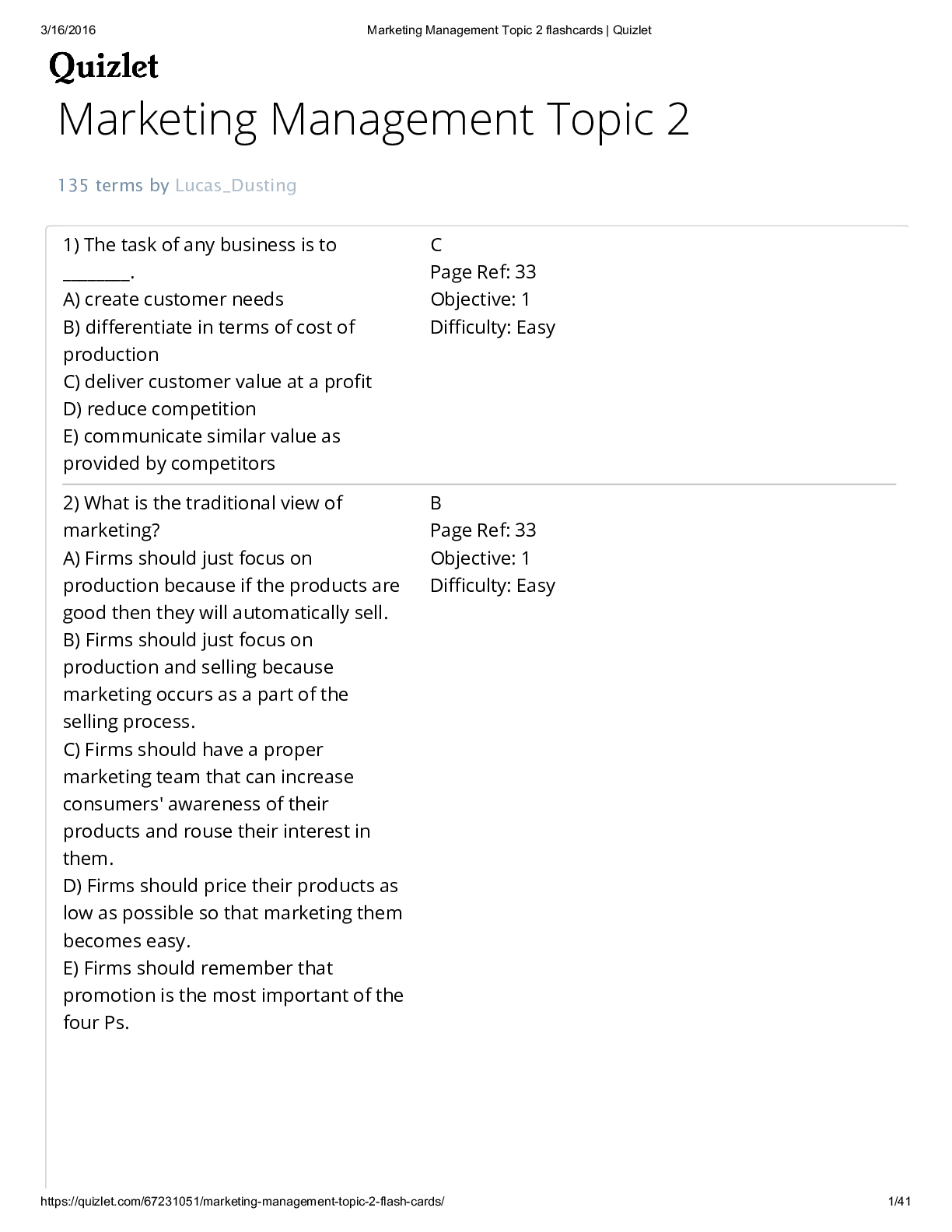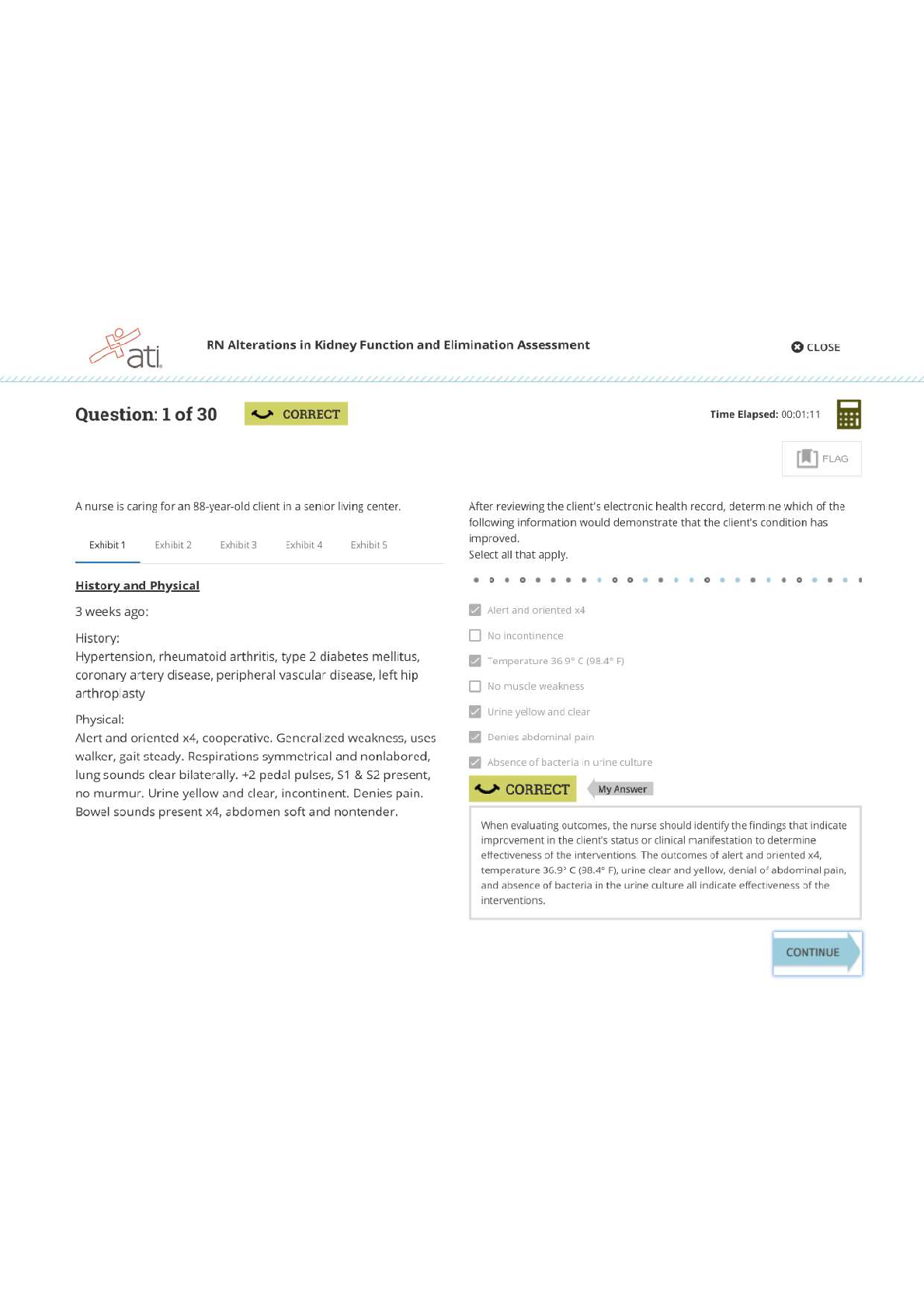BIOL 3332 Exam 1: PRINTABLE VERSION. Reviewed and correct answers provided.
Document Content and Description Below
BIOL 3332: PRINTABLE VERSION Test 1 You scored 76.52 out of 103 NB: The red highlights are the Wrongs corrected by the yellow highlights Question 1 . The choices below each list three groups of... organisms. For which choice, do all three groups have members that are considered microbes and are not a functional part of a multicellular organism? A) protozoans, fungi, bacteria B) animals, archaea, plants C) protozoans, bacteria, animals D) viruses, algae, archaea E) two of the above are correct Question 2 Your answer is INCORRECT. The taxonomic classification of microorganisms has evolved over the past 200 years. Which of the following statements regarding microbial taxonomy is false? A) Kingdom Monera was created to contain only prokaryotic cell types. B) Currently, microbes are spread out over four taxonomic groupings (Kingdoms). C) More recent (1970's) analysis revealed there to be actually two taxonomic groupings of prokaryotic cells. D) At one time, all microorganisms were contained in a single taxonomic grouping, Kingdom Protista. E) None of A-D are false; they are all true statements. Question 3 . Staphylococcus aureus, like all bacteria reproduce asexually by binary fission to produce clones. Regardless of this latter fact, all the cells of a colony of Staphylococcus aureus on solid growth medium would not necessarily be genetically identical. A) True B) False Question 4 . The statements: "this is the age of bacteria and bacteria have always been dominant" or "bacteria rule the world" would be based on which statement(s)? A) The fact that bacteria have such a diverse array of metabolic capabilities that many other life forms depend on. B) The fact that they are found almost everywhere on Earth (i.e., ubiquitous) C) The fact that they represent the oldest forms of life on Earth. D) All the above are statements supporting these statements. Question 5 . Pasteur observed: (a) that microbes were responsible for chemically transforming organic material to different end products in the absence of air; (b) that each type of transformation was defined by the particular end product(s) formed; and (c) that a specific microbe was responsible for each type of transformation and resulting end product(s). These observations collectively became known as the: A) germ theory of disease B) germ theory of enrichment culture. C) germ theory of fermentation. D) the principle of immunization. E) the spontaneous generation theory. Question 6 . Which historical figure in microbiology is not correctly matched with his/their proper achievement? A) Leeuwenhoek: first to see microorganisms B) Robert Hooke: first to view life by observing macroscopic organisms with a microscope C) Winogradsky and Beijerinck: founders of microbial ecology; importance of bacteria in nitrogen cycle D) Edward Jenner: discovered and developed use of antibiotics to fight infection. E) Lister and Semmelweis: hygienic practices and use of antiseptics minimize bacterial infection Question 7 . The first of Koch's postulates A) involves isolation of the suspected bacterial pathogen from a healthy animal. B) shows that the suspected microbe is found in all cases of the disease, but absent from healthy animals. C) involves injecting the isolated microbe into a healthy animal. D) involves administering antibiotics to diseased animals to see which works best. Question 8 Your answer is INCORRECT. Regarding Louis Pasteur's experiments with the S-neck flask, which of the following statements is true? A) Air exchange was involved. B) A food source was provided. C) The possibility of contamination was removed. D) All preexisting microorganisms were killed. E) All of the answers are correct. Question 9 . Which of the following is applicable to an attenuated virus or bacterium? A) They are more powerful pathogenic forms of the virus or bacterium. B) They are forms that can be used as vaccines to protect against certain diseases. C) They are types of antibiotics. D) none of the above are applicable to an attenuated virus or bacterium. Question 10 Your answer is INCORRECT. Metagenomics is a technique used to identify un-culturable microorganisms from environmental samples. A) True B) False Question 11 Your answer is INCORRECT. The diagram shows the bacterial metabolic activities in a particular ecosystem as shown by the uptake/ release of certain molecules; four of these metabolic processes are labeled 1 through 4. Which of the following terms or features is not correctly matched with the proper metabolic process? A) Chemolithotroph: 4 B) Cyanobacteria: 3 C) Heterotroph: 2 D) Often found in bacteria:plant symbiotic relationships: 1 E) All are correctly matched. Question 12 . Among choices A-D, which is not true regarding the domains Bacteria, Archaea, and Eukarya? A) They are taxonomic groupings based on comparison of ribosomal RNA gene sequences. B) They represent two groups of prokaryotes and one eukaryotic group. C) Archaea tends to occupy extreme environments, and thus have little, if anything, in common with eukaryotic cells. D) Domain Eukarya evolved after the other two domains. E) A-D are all true statements. Question 13 . Which choice below is incorrect? A) Reductive evolution: the loss of DNA encoding unselected traits. B) Genes used as molecular clocks: reveal the history of organisms through accumulated changes in those sequences. C) Natural selection: source of genetic divergence between organisms D) Prokaryotic species: are defined the same way as most eukaryotic species are defined Question 14 . DNA:DNA hybridization or 16S rRNA gene sequence analysis, in conjunction with examining the ecological role of the organism in question is how one can define A) a fermentation B) a bacterial species C) an autotroph or heterotroph D) a pathogen Question 15 Your answer is INCORRECT. Since many prokaryotic genes have been acquired via horizontal gene transfer, this can complicate the interpretation of molecular phlyogenies. To minimize this effect, gene sequences used for such comparisons employ operational genes, such as those involved in metabolism or pathogenicity, since these are unlikely to have been acquired by horizontal gene transfer. A) True B) False Question 16 . Which of the following is incorrect? A) streptococci: chains of round (circular) shaped cells B) fimbriae: some prokaryotes have these for attachment to surfaces C) bacteria tend to maintain a hypotonic intracellular environment relative to the cell exterior D) the nucleoid region of a bacterium is only contained within the cell's plasma membrane E) axial filament: involved in spirochete motility Question 17 . Which of the following would occur if a motile bacterium were moving towards an attractant? A) a lower frequency of clockwise rotation of flagella B) a greater frequency of counterclockwise rotation of flagella C) an increase in the frequency of tumbles D) A, B, and C are correct E) A and B are correct F) B and C are correct Question 18 . Aquatic bacteria might have these structures to help orient them to the proper depth of water. A) Magnetosomes B) Carboxysomes C) Metachromatic granules D) Gas vacuoles E) none of A-D are correct F) two of A-D are correct Question 19 . The diagram above represents two cell wall types found among bacteria. Which of the following is correct regarding these cell wall types? A) Gram-positive cell: B B) Lipopolysaccharide layer found here: A C) Murein lipoproteins would be attached to this: A D) In these cells, part of this can act as an endotoxin: found in B E) This helps protect bacteria against high osmotic pressure: only found in A Question 20 . FtsZ protein, MreB protein, and CreS (crescentin) protein are associated with A) the bacterial cytoskeleton B) peptidoglycan C) bacterial flagella D) bacterial shape/form, and cell division E) two of the above are correct Question 21 Your answer is INCORRECT. Which of the following is not a possible chemical component of a bacterial cell wall? A) N-acetylglucosamine B) N-acetylmuramic acid C) O polysaccharide D) amino acids E) all are possible components of a bacterial cell wall Question 22 Your answer is INCORRECT. With respect to solute concentrations, bacteria tend to maintain their interior A) with a lower solute concentration relative to the external environment. B) isotonic so the cells can maintain their shape. C) slightly hypertonic relative to the external environment. D) so that solutes move out of the cell via active transport. Question 23 . __________ are found in the plasma membrane and help to reinforce and stiffen membranes in bacteria. A) Hopanoids B) Inclusions C) Cholesterol molecules D) Peptidoglycans Question 24 . Certain bacteria have atypical cell wall features; for example, many ___________ possess membrane lipids comprised of terpenoid compounds rather than fatty acids; ______________ have large waxy lipids on the exterior of their peptidoglycan layer; and _________________ species completely lack a cell wall altogether. A) Archaea; Mycoplasma; Mycobacteria B) Archaea; Mycobacteria; Mycoplasma C) Mycobacteria; Archaea; Mycoplasma D) Archaea; Staphylococcus; E. coli Question 25 . Medium 3 is A) selective. B) differential. C) both selective and differential. D) Neither selective nor differential Question 26 . Amino acids, vitamins, or other factors that must be supplied to a cell because it cannot synthesize them is A) macronutrients B) micronutrients C) essential nutrients D) trace elements E) None of the above. Question 27 . By the way humans obtain carbon and energy, we are considered: A) chemoheterotrophs B) photoautotrophs C) chemolithotrophs D) photoheterotrophs Question 28 Your answer is INCORRECT. The growth phases of a bacterial culture are shown. Which of the following statements pertaining to this growth curve is false? A) Penicillin would be most effective in killing this culture if added during phase "c" B) Transfer of cells from a defined minimal medium to a complex (rich) medium would shorten the length of phase "a" C) If this culture were capable of endospore formation, it would probably start to happen during phase "c" and continue into phase "d" D) Exponential changes in cell numbers occur in phases "b" and "d" E) None are false; all the above statements are true. Question 29 . Which statement among A-D is not accurate regarding generation time? A) it is the length of time needed for a cell to divide B) it could change for a species depending on the type of medium it is growing on C) it is the length of time needed for a population to double D) it is generally specified in minutes; i.e., minutes per generation E) All of A-D are true. Question 30 . Four cells with generation times of 15 minutes are inoculated into a culture medium. How many cells are there after 3 hours? (formula: NT = N0 x 2n) A) 12 B) 16,384 C) 4,096 D) 128 E) 256 Question 31 . Bacterium X has a generation time of 25 minutes. Starting with 20 cells in log phase, how long does it take to produce about 100,000 cells? [ n = log10(NT/N0)/0.301] A) about 24 hours B) about 307 minutes C) about 5000 minutes D) about 150 minutes Question 32 . Which statement below is false? A) Removal of samples for dry cell weight analysis of a bacterial culture would not be a viable count method. B) Generally the best method for determining CFU/mL of a bacterial culture is to take optical density measurements of the sample. C) Quantification of cell numbers of a culture via microscopy using a Petroff-Hauser counting chamber can include counts of both live and dead cells. D) Filtration is a direct count method of determining cell numbers in a culture. E) 1 mL of a culture sample diluted to 1/103 was plated on media and yielded 40 colony forming units; the sample contains 4 x 104cfu/mL. Question 33 Your answer is INCORRECT. Which is not applicable to endospore formation? A) Aggregation of cells, attachment to a surface, and formation of an extracellular polysaccharide matrix are part of the process of endospore formation. B) Formation of a mother cell occurs during the process. C) It is triggered under sub-optimal growth or adverse environmental conditions. D) Dipicolinic acid and calcium ions play an important role in making the spore highly resistant to environmental conditions. E) It is a property found in members of genus Bacillus and genus Clostridium. Question 34 . Free Points! A) Choose me Question 35 . BONUS The size of their chromosome, the fact they have only one chromosome, and the lack of a nuclear membrane are some reasons why A) bacteria are so energetic B) bacteria can increase in number so fast C) bacteria possess a cell wall D) bacteria ferment [Show More]
Last updated: 1 year ago
Preview 1 out of 10 pages
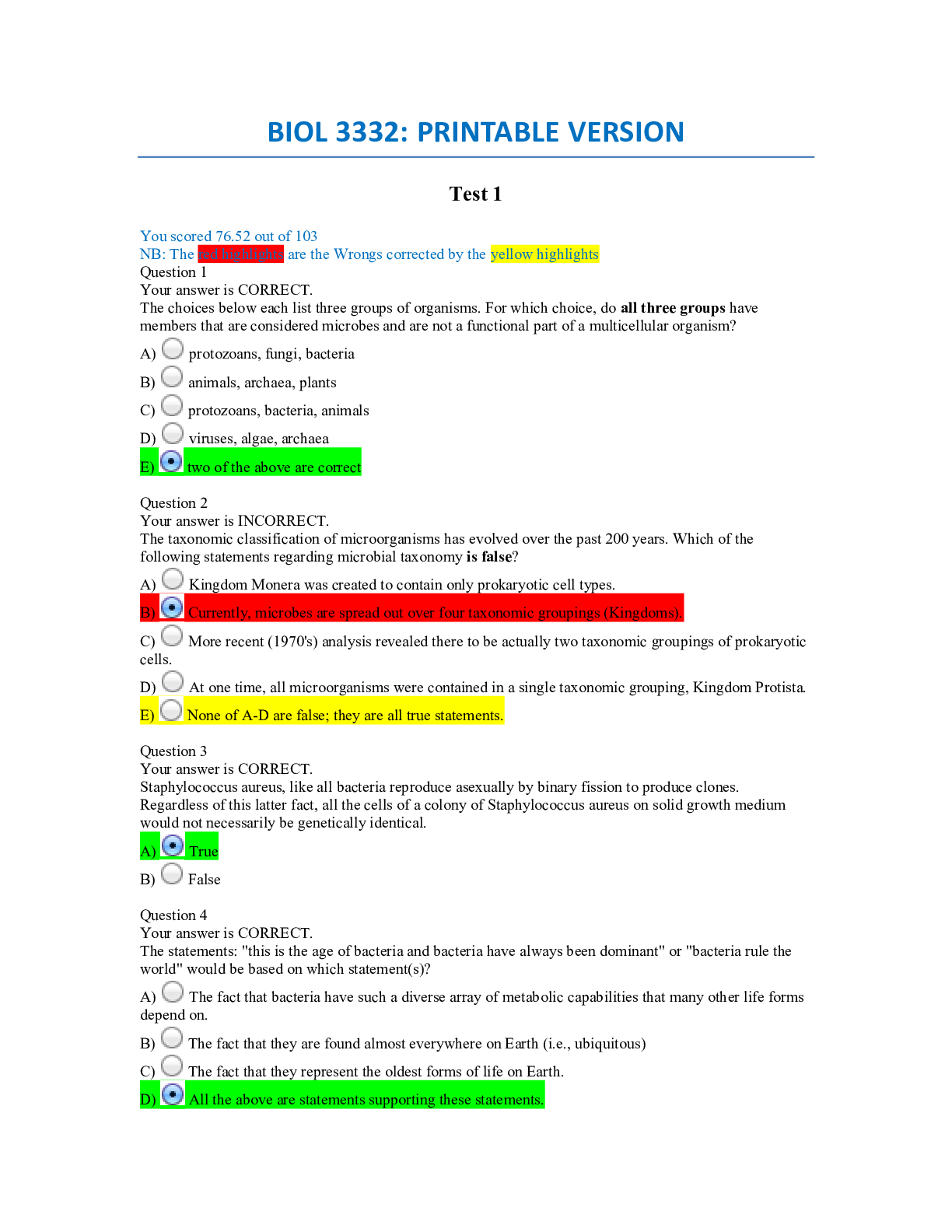
Reviews( 0 )
Document information
Connected school, study & course
About the document
Uploaded On
Sep 22, 2020
Number of pages
10
Written in
Additional information
This document has been written for:
Uploaded
Sep 22, 2020
Downloads
0
Views
71


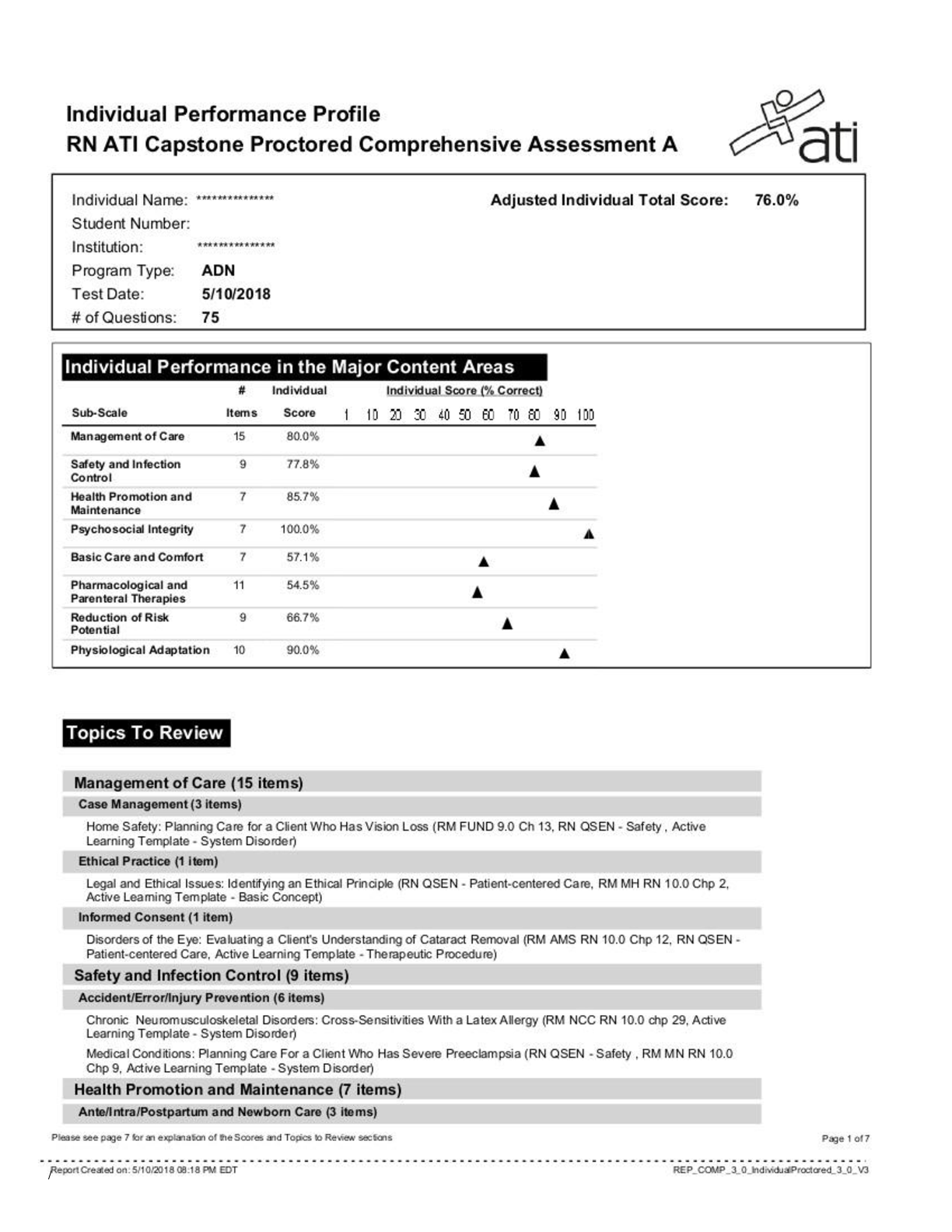
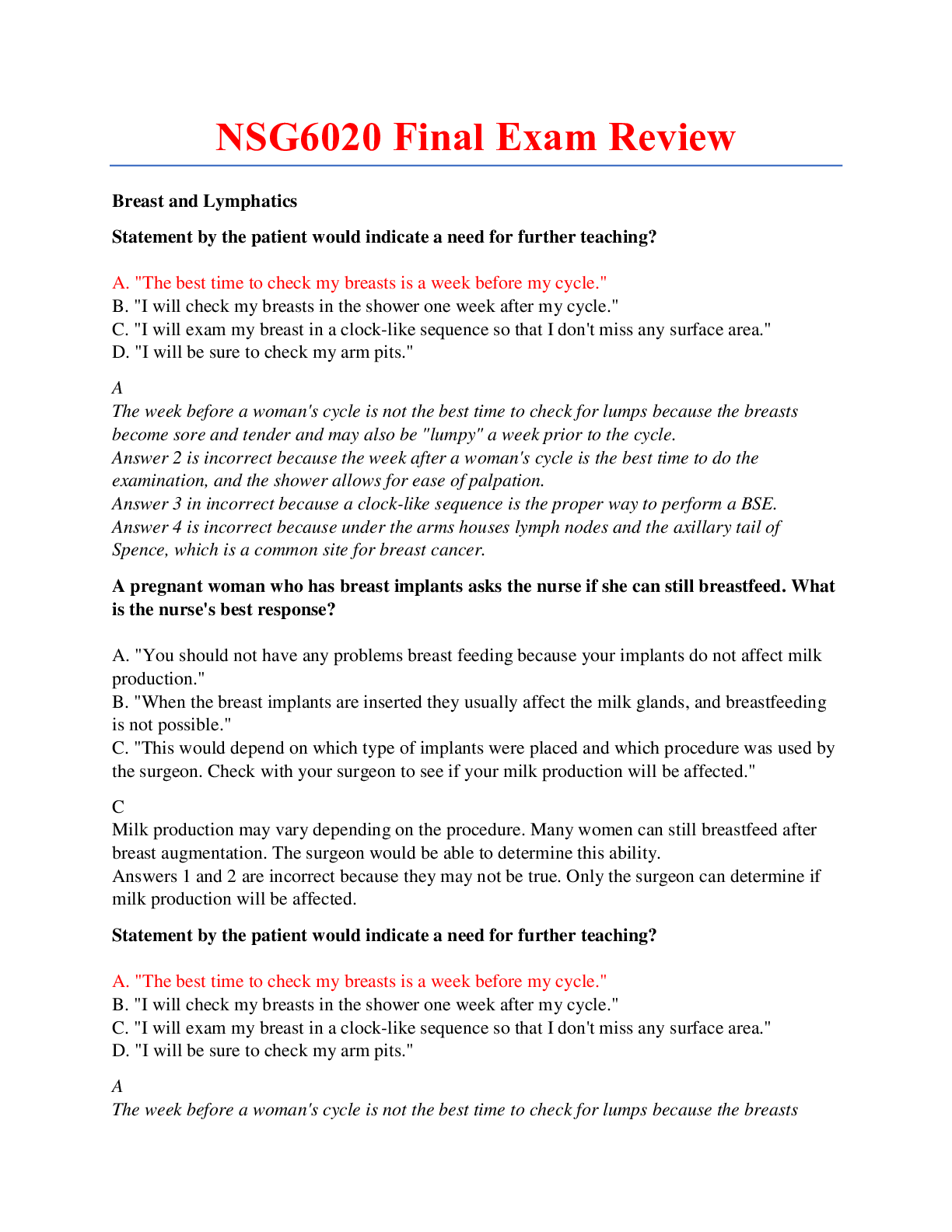

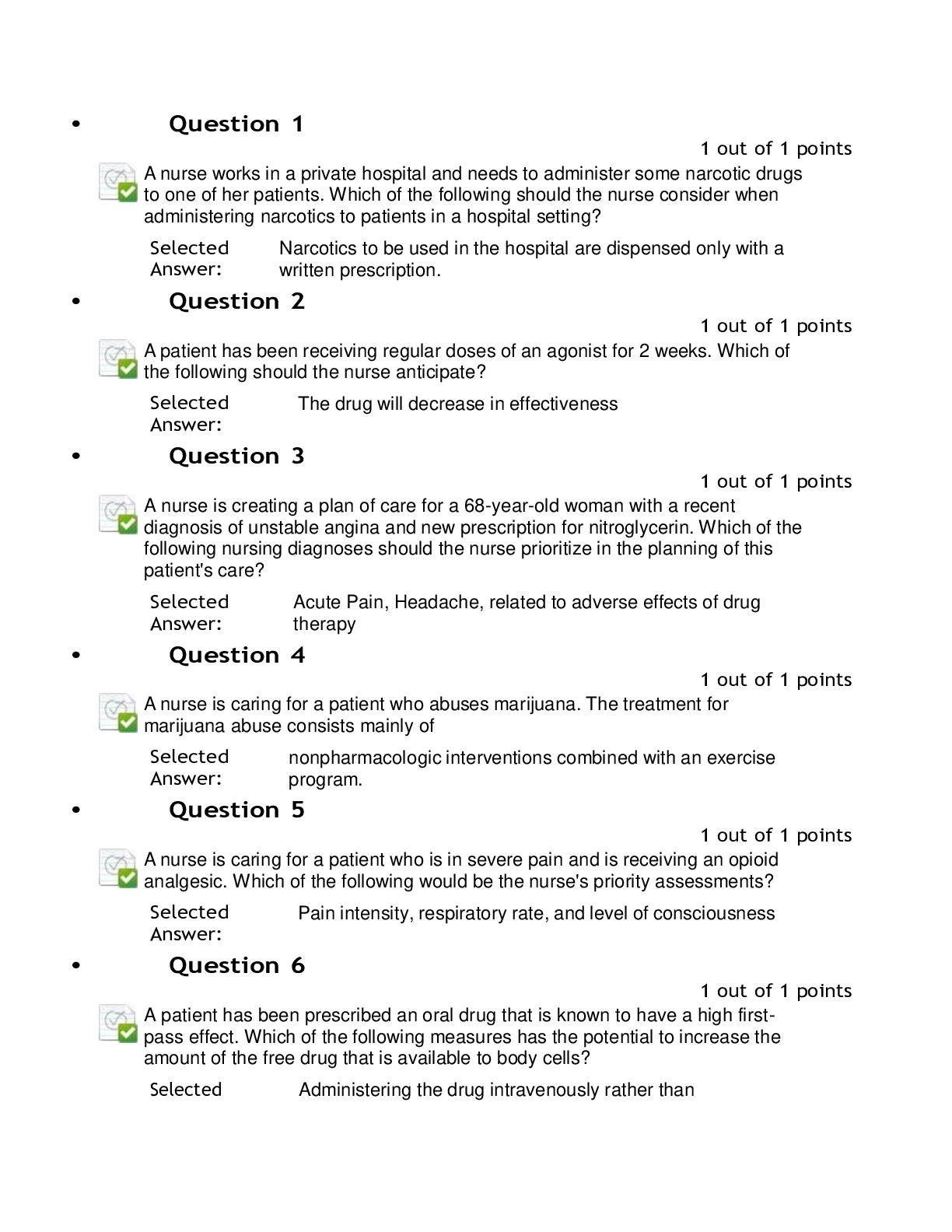

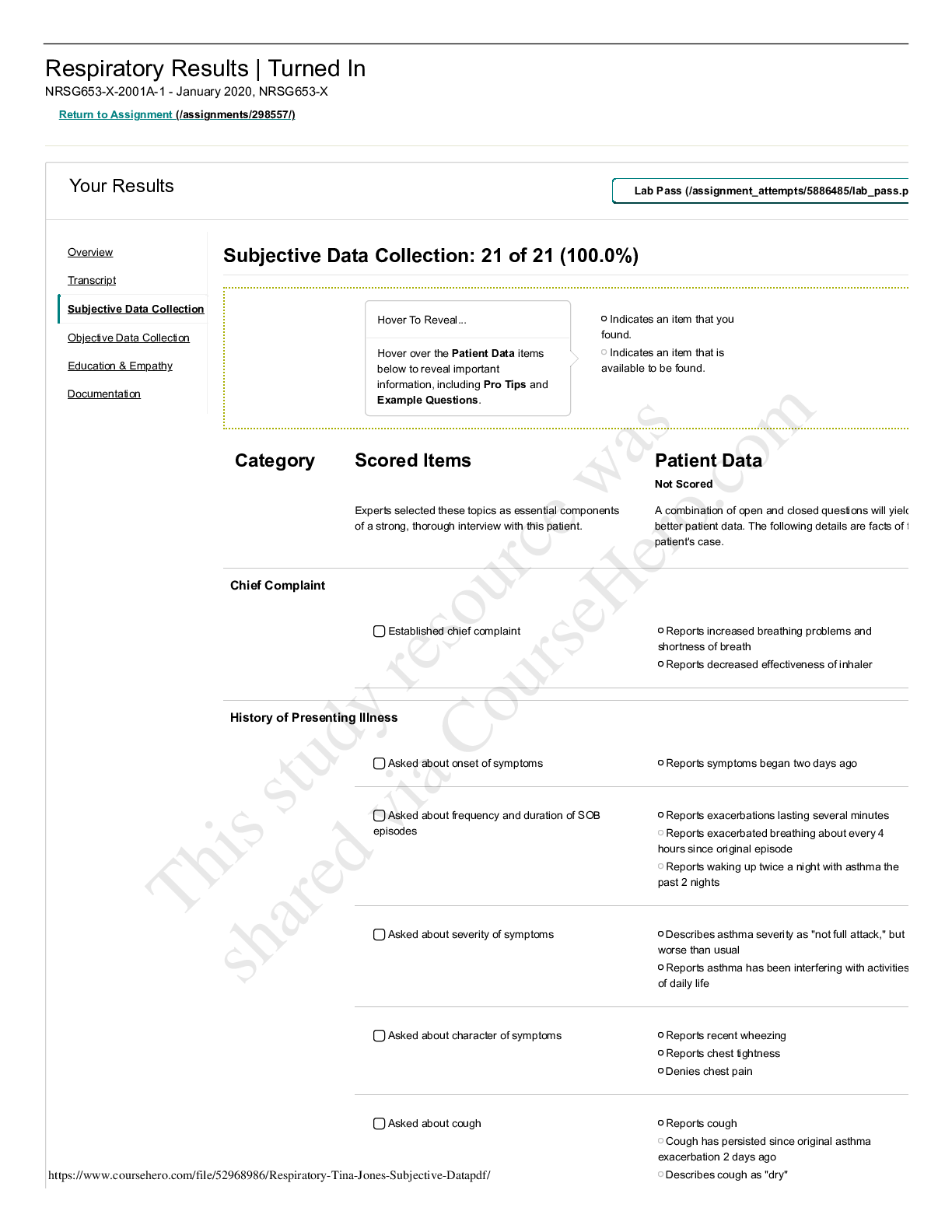





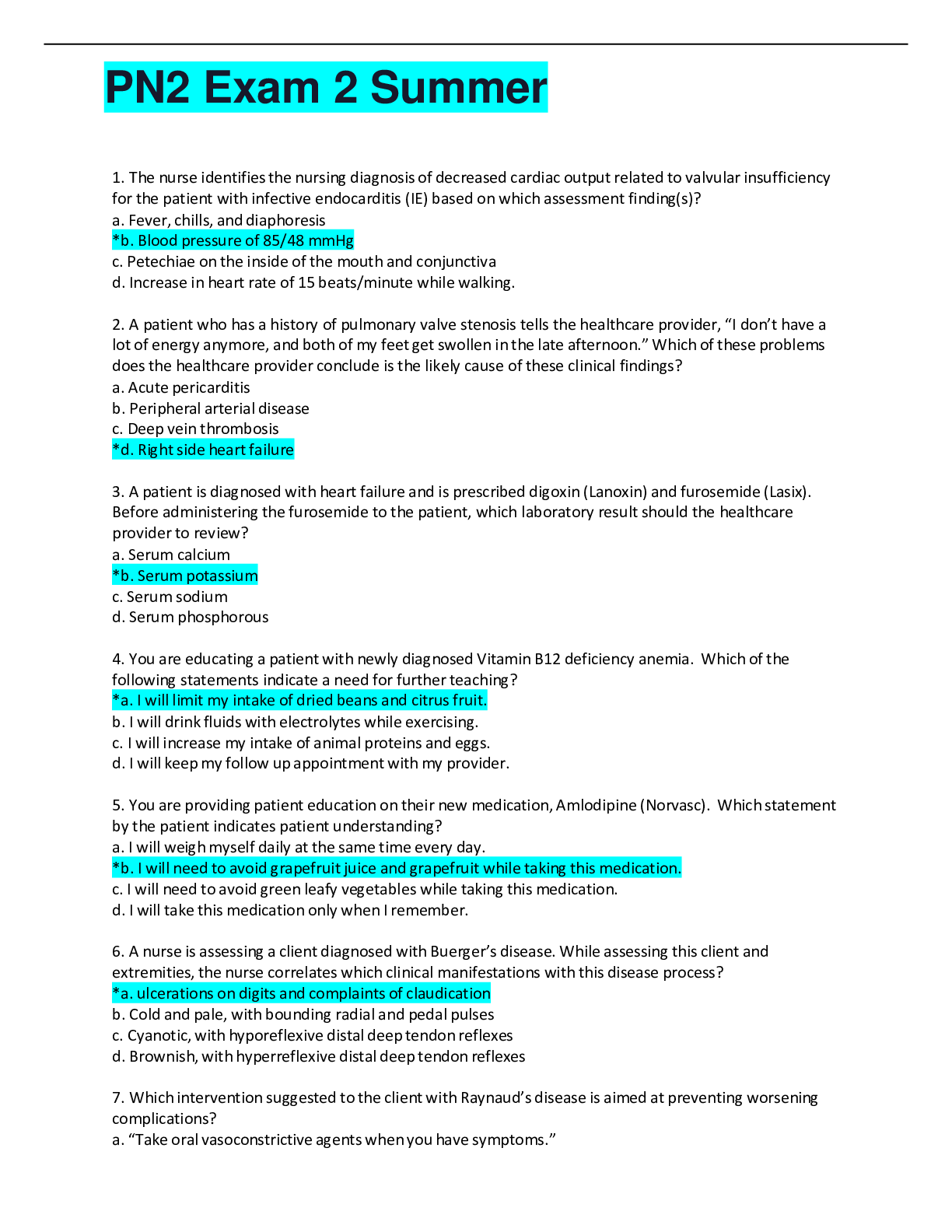



.png)

